Introduction
Below you will find the course descriptions, learning outcomes, and attendee instructions for webinars offered through Evolve Forensics. Please visit the Schedule for specific dates and times. Please contact Alice White at [email protected] if you would like to schedule a private webinar or webinar series for your agency.
Your webinar instructors include: Dr. Glenn Langenburg (Elite Forensic Services) and Alice White (Evolve Forensics). These instructors have both been active in casework, research, standards development, and instruction since the earliest stages of their careers. Glenn and Alice both excel at breaking down complex concepts into useful kernels of information and packing an incredible number of kernels into a short burst of time.
General Information
Webinar Attendance Policy: Webinars may only be attended by those registered for the webinar. Evolve Forensics does not permit broadcasting, watching, listening, or distributing the webinar or any of the webinar handouts to individuals who are not registered for the specific webinar.
Rescheduling and Cancellations: To reschedule or cancel a registration, please contact Alice White via email: [email protected]
Software Requirements: Attendees are typically able to watch, listen, and participate via computer/tablet. If the attendee experiences audio issues with their computer/tablet, they can watch and participate on a computer/tablet and listen via phone. A computer with a functioning microphone is not required as attendees can type out questions and comments into the webinar platform. Attendees must be able to access GoToWebinar (webinar platform) and SurveyMonkey (quiz platform).
While the wonderful world of technology makes distance learning possible, it is not always problem-free. If the attendee has connection problems and cannot join the webinar (or completely loses connection during the webinar), the attendee will be rescheduled.
Descriptions
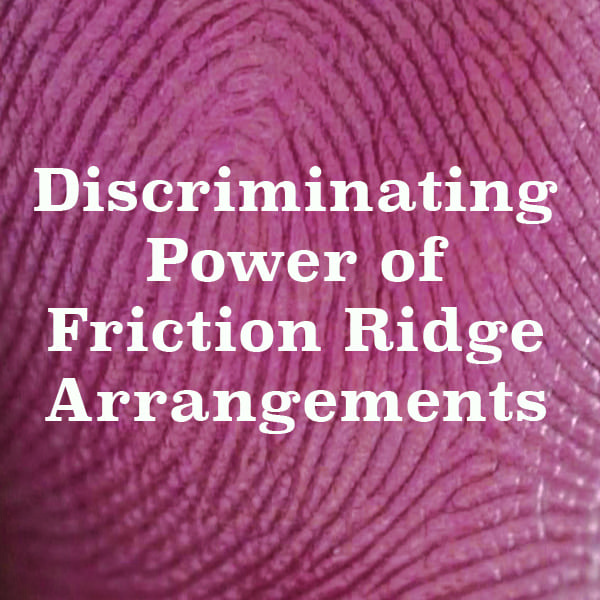
Discriminating Power of Friction Ridge Arrangements
Approved for four (4) hours toward IAI Latent Print and Tenprint Certification and Recertification.
Instructor: Alice White
Duration: 4 hours
Did you know the suggestion that “ridge units line up to form ridges” is based on a historical theory proposed in biology in the 1800’s called the theory of recapitulation? Although the theory of recapitulation was handed a death knell in the mid-1900’s by the budding field of genetics, the idea that “ridge units line up to form ridges” continued into the afterlife via the friction ridge discipline. In reality, embryologists have never observed ridge units lining up to form ridges in the friction ridge skin.
Did you know there are three factors (genetics, environment, and developmental noise) that are cited by biologists as causing variation in any trait, including the features in the friction ridge skin? When studying biological sources of variation in any given trait, “differential growth” is not listed as a reason. Why? Because “differential growth” does not mean “variable” or “unique”.
These misconceptions and more will be addressed as this lecture explores the following questions: Based on actual observations from embryologists, what is the sequence of events that leads to the formation of the friction ridge skin? What is developmental noise? What is developmental stability? What is fluctuating asymmetry? Why are some aspects of the friction ridge skin useful for determining the anatomical origin (finger, palm, foot) and distal orientation (up) of a latent print? Why are the arrangements of the ridges in the friction ridge skin highly discriminating? Which features of the friction ridge skin do twins tend to share in common and why? Why do people have different fingerprints on their own fingers? Why do pattern force regions tend to have a high density of common minutiae (ending ridges and bifurcations) all pointing the same direction? Why do thumbs and index fingers have more minutiae, and more variety of complex minutiae, than the other fingers? Everything starts with the skin…
Learning Outcomes:
- The attendee will be able to recognize the following: surface ridge, surface furrow, primary ridge, and secondary ridge.
- The attendee will be able to list the factors that influence human variation.
- The attendee will be able to define developmental stability and developmental noise.
- The attendee will be able to indicate the three major contributors to friction ridge skin growth stresses.
- The attendee will be able to list the basic sequence of events during the formation of the friction ridges.
- The attendee will be able to identify factors that create low specificity or high specificity combinations of ridge features.
- The attendee will be able to identify the reasons monozygotic twins share remarkable similarity in patterns and ridge counts on corresponding fingers.
- The attendee will be able to recognize regional variation in minutiae directions.
- The attendee will be able to recognize regional variation of minutiae densities.
Course Handout: Prior to the webinar (typically 1 – 2 days) you will receive an email link to a file or folder to download the handout and any relevant supplemental information. The main course handout can also be downloaded from the webinar platform at the time of the webinar.
Assessing Learning Outcomes (a.k.a. Quiz): In order to verify the learning outcomes have been achieved, there is a 20 question quiz via SurveyMonkey at the end of each webinar. Attendees must score a minimum of 70% on the quiz in order to receive a training certificate for the webinar. Please note the quizzes are open-book and poll questions are given during the webinar to prepare attendees for the quiz.
Attendance Policy: This webinar may only be attended by the person who is registered for the webinar. Evolve Forensics does not permit broadcasting, watching, listening, or distributing the webinar or any of the webinar handouts to individuals who are not registered for this webinar.
Software Requirements: Attendees must be able to access GoToWebinar (webinar platform) and SurveyMonkey (quiz platform) in order to participate.
The following YouTube Video shows how to use GoToWebinar as an attendee: https://youtu.be/IQ3Xwwgbd8Y
Questions?
Please contact Alice White via email at [email protected]
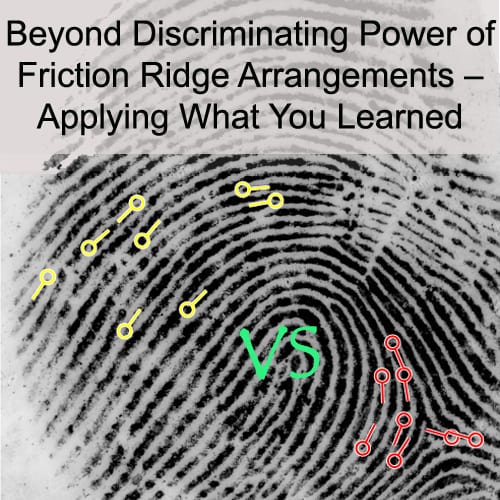
Beyond the Discriminating Power of Friction Ridge Arrangements – Applying What You Learned
Approved for four (4) hours toward IAI Latent Print Certification and Recertification.
Instructor: Dr. Glenn Langenburg
Duration: 4 hours
In this webinar, attendees will apply the fundamental concepts highlighted in “Discriminating Power of Friction Ridge Arrangements”. Participants will have a chance to analyze latent prints and guesstimate specificity using their ‘training and experience’ factor (e.g., ‘subjective probability’). Then we will compare our predicted results to output results from a statistical model that uses an AFIS database (approximately 1 million fingerprints) to estimate the relative specificity for given configurations.
Learning Outcomes:
- The attendee will be able to list the significant research on this topic.
- The attendee will be able to define the concept of specificity.
- The attendee will be able to describe how developmentally stable features and developmentally ‘noisy’ features directly impact the specificity of the characteristics.
- The attendee will be able to demonstrate how specificity relates to ‘suitability’ and ‘sufficiency’ determinations.
- The attendee will understand how the specificity of minutiae arrangements, and not the number of minutiae, is the critical factor for determining ‘suitability’ and ‘sufficiency’.
- The attendee will be able to recognize how different regions of the fingers/palms can influence minutiae densities, orientation, and arrangements.
- The attendee will be able to predict the relative specificity of various clusters of minutiae, based on region of the finger, orientation, type of minutiae, and spatial relationships.
- The attendee will be able to recognize factors in close non-matches that can lead to errors.
- The attendee will be able to list steps that can be taken to minimize error when using AFIS.
Course Handout: You will receive an email link several days before class to download the handouts and images. This will give you an opportunity to come to the webinar with the exercises already prepared and we can discuss as a group. The pre-course work may take about an hour to review. If you are unable to download or work the exercises in time, you can still participate in the webinar, but you will have less time to review the exercises in real time.
Course Pre-Requisites: It is helpful, but not required, to attend Discriminating Power of Friction Ridge Arrangements (taught by Alice White). You do not need to know anything about statistics, statistical models, or probability theory. We will touch on these topics, but in a very practical and understandable manner, and as they relate to demonstrating the learning outcomes.
Post-Course: There will be an opportunity to have a few post-course exercises on your own. Glenn will set up ‘office hours’ where participants may come and discuss, receive feedback, learn ground truth, etc.
Assessing Learning Outcomes (a.k.a. Quiz): In order to verify the learning outcomes have been achieved, there is a 20 question quiz via SurveyMonkey at the end of each webinar. Attendees must score a minimum of 70% on the quiz in order to receive a training certificate for the webinar. Please note the quizzes are open-book and poll questions are given during the webinar to prepare attendees for the quiz.
Attendance Policy: This webinar may only be attended by the person who is registered for the webinar. Evolve Forensics does not permit broadcasting, watching, listening, or distributing the webinar or any of the webinar handouts to individuals who are not registered for this webinar.
Software Requirements: Attendees must be able to access GoToWebinar (webinar platform) and SurveyMonkey (quiz platform) in order to participate.
The following YouTube Video shows how to use GoToWebinar as an attendee: https://youtu.be/IQ3Xwwgbd8Y
Questions?
For questions regarding the course content, please contact Glenn Langenburg via email at [email protected]
For questions regarding registration and payment processes, please contact Alice White via email at [email protected]
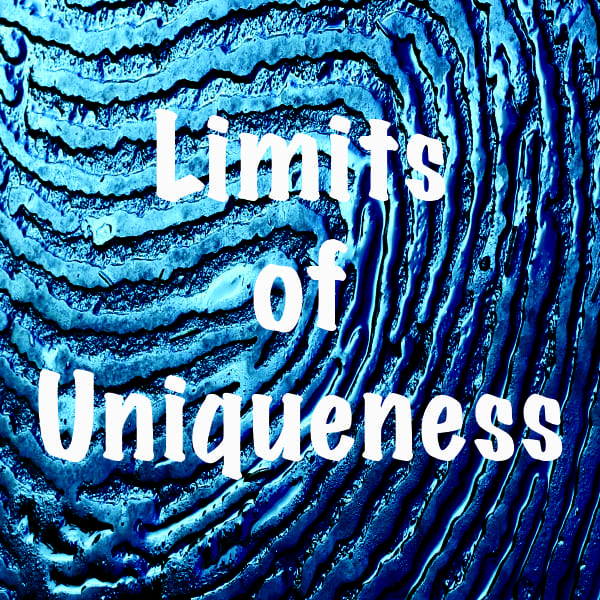
Limits of Uniqueness in the Friction Ridge Impressions
Approved for four (4) hours toward IAI Latent Print and Tenprint Certification and Recertification (can be applied toward testimony training hours).
Instructor: Alice White
Duration: 4 hours
Why can impressions of the friction ridge skin be used as a means of identification? This webinar will unpack the important differences between the following responses:
Response #1 “Fingerprints, palm prints, and footprints can be used as a means of identification because they are unique and permanent. Each fingerprint, palm print, and footprint in the world is unique and these prints remain unchanged from before birth until decomposition after death.”
Response #2 “Impressions of the friction ridge skin are a valuable means of identification because of the nature of the skin itself and because of the comparison skills exhibited by trained examiners. As far as the skin is concerned, the features the friction ridge skin show remarkable variation in the population, which means these features can be used to tell one person from another. Many of the skin’s features are also relatively stable over time, which means they can be used to track a person from one year to the next. Most importantly, trained examiners demonstrate a high degree of accuracy when assessing these features to determine the source of a given impression.“
The first response contains over-simplified statements that can be disputed with published research and glosses over one very important aspect of using prints as a means of identification – it requires an examiner! The second response can be supported with published research and avoids exposing an examiner to impeachment with published treatises during testimony.
Learning Outcomes:
- The attendee will be able to identify important contextual information regarding historical statements about uniqueness in textbooks published by Galton; Cummins & Midlo; Wentworth & Wilder; Ashbaugh; and Tuthill & George.
- The attendee will be able to indicate the proper definition of differential growth and the impact of differential growth on the friction ridge skin.
- The attendee will be able to identify the source of the flawed assumption that ridge units line up to form ridges during embryological development of the friction ridge skin.
- The attendee will be able to identify important contextual information regarding historical statements about permanence.
- The attendee will be able to identify key events that warned the friction ridge community about limits to uniqueness.
- The attendee will be able to identify factors that have impeded the friction ridge community’s ability to re-frame issues regarding the concept of uniqueness.
- The attendee will be able to indicate the main criticisms of extolling the virtues of global uniqueness of fingerprints, palm prints, and footprints.
- The attendee will be able to recognize those statements that explicitly or implicitly invoke the world’s population.
- The attendee will be able to recognize over-statements regarding “permanence” of the features of the friction ridge skin.
- The attendee will be able to describe the importance of incorporating examiner accuracy early in testimony as a foundation of friction ridge examinations.
Course Handout: Prior to the webinar (typically 1 – 2 days) you will receive an email link to a file or folder to download the handout and any relevant supplemental information. The main course handout can also be downloaded from the webinar platform at the time of the webinar.
Assessing Learning Outcomes (a.k.a. Quiz): In order to verify the learning outcomes have been achieved, there is a 20 question quiz via SurveyMonkey at the end of each webinar. Attendees must score a minimum of 70% on the quiz in order to receive a training certificate for the webinar. Please note the quizzes are open-book and poll questions are given during the webinar to prepare attendees for the quiz.
Attendance Policy: This webinar may only be attended by the person who is registered for the webinar. Evolve Forensics does not permit broadcasting, watching, listening, or distributing the webinar or any of the webinar handouts to individuals who are not registered for this webinar.
Software Requirements: Attendees must be able to access GoToWebinar (webinar platform) and SurveyMonkey (quiz platform) in order to participate.
The following YouTube Video shows how to use GoToWebinar as an attendee: https://youtu.be/IQ3Xwwgbd8Y
Questions?
Please contact Alice White via email at [email protected]
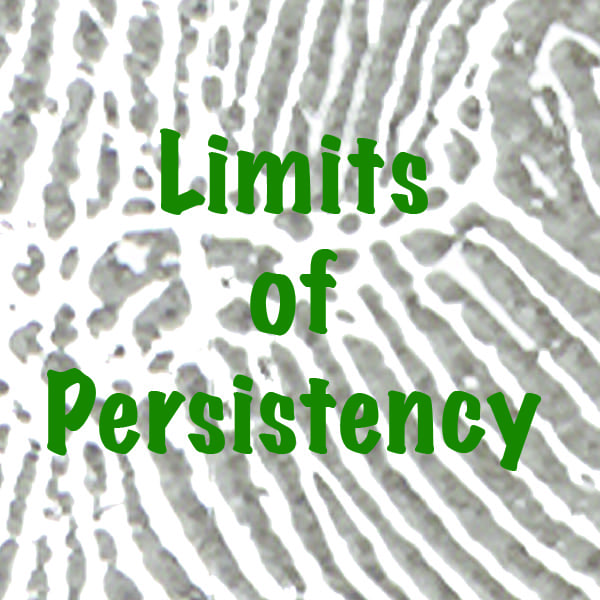
Limits of Persistency in the Friction Ridge Skin
Approved for four (4) hours toward IAI Latent Print and Tenprint Certification and Recertification.
Instructor: Alice White
Duration: 4 hours
This webinar is adapted from elements of the Analysis of Distortion in Latent Prints workshop that Alice has taught since 2006. Tenprint and latent print examiners should be aware that the friction ridge skin is not permanent, nor globally persistent, from before birth until decomposition after death. In this webinar Alice will introduce the changes that take place in the friction ridge skin throughout your lifetime.
The first changes actually take place in the skin as the hands and feet grow to their adult size. Did you know that some ridges will predominantly grow in length while others predominantly grow in width? This growth process actually alters certain aspects of the friction ridge skin.
During the busy lifetime of an individual, the skin can change due to injuries and disease. Sometimes these issues are temporary, and the skin returns to the “pre-injury” or “pre-disease” state. Other times however, injuries can alter ridge patterns, ridge paths, and minutiae.
As people pass through middle age, changes occur once again. Did you know that incipient ridges tend to blossom in the furrows throughout your lifetime? Are you aware that the ridges themselves tend to change in length and width and that ridge edge shapes often change dramatically with age?
This lecture will provide numerous examples and explain how these changes take place. This will help friction ridge examiners to 1) recognize common changes in the friction ridge skin, 2) recognize the conditions under which to expect these types of changes and 3) explain differences caused by these changes based on the anatomy and physiology of the friction ridge skin.
Learning Outcomes:
- The attendee will be able to list the three tissues of the skin.
- The attendee will be able to identify the types of cells in the epidermis and their function.
- The attendee will be able to describe the changes in the friction ridge skin that take place as a foot or hand grows to adult size.
- The attendee will be able to recognize warts and psoriasis/eczema in the friction ridge skin.
- The attendee will be able to describe the difference between superficial damage and scars.
- The attendee will be able to indicate the impact of time on superficial damage and scars.
- The attendee will be able to recognize scars in the friction ridge skin.
- The attendee will be able to explain the reasons scars can look more or less severe.
- The attendee will be able to describe the major changes that take place in the friction ridge skin with advanced age.
- The attendee will be able to identify the underlying reasons for age-related changes in the friction ridge skin.
Course Handout: Prior to the webinar (typically 1 – 2 days) you will receive an email link to a file or folder to download the handout and any relevant supplemental information. The main course handout can also be downloaded from the webinar platform at the time of the webinar.
Assessing Learning Outcomes (a.k.a. Quiz): In order to verify the learning outcomes have been achieved, there is a 20 question quiz via SurveyMonkey at the end of each webinar. Attendees must score a minimum of 70% on the quiz in order to receive a training certificate for the webinar. Please note the quizzes are open-book and poll questions are given during the webinar to prepare attendees for the quiz.
Attendance Policy: This webinar may only be attended by the person who is registered for the webinar. Evolve Forensics does not permit broadcasting, watching, listening, or distributing the webinar or any of the webinar handouts to individuals who are not registered for this webinar.
Software Requirements: Attendees must be able to access GoToWebinar (webinar platform) and SurveyMonkey (quiz platform) in order to participate.
The following YouTube Video shows how to use GoToWebinar as an attendee: https://youtu.be/IQ3Xwwgbd8Y
Questions?
Please contact Alice White via email at [email protected]

Basic Fingerprint Distortion
Approved for four (4) hours toward IAI Latent Print and Tenprint Certification and Recertification.
Instructor: Alice White
Duration: 4 hours
This webinar is adapted from elements of the Analysis of Distortion in Latent Prints workshop that Alice has taught since 2006. In this webinar Alice will introduce basic concepts in contact mechanics (what happens to the skin when it makes contact with a surface) and the transfer of friction ridge features to impressions under four common circumstances.
We will explore basic touches under different deposition pressures and evaluate the changes in the following: overall size and shape of a fingerprint, ridge and furrow width, feature type, edge shapes, incipient ridges, and wrinkles/secondary creases.
Further, we will explore anomalies and difficulties presented by skin that wobbles on the surface, double touches/overlays, and double taps. Numerous images and videos will be used to illustrate these commonly encountered distortions.
While this class is titled “Basic”, this course covers some challenging interpretation issues related to tonal issues created when the skin wobbles on the surface, sources of false minutiae, and the illusion of continuity created by double touches and double taps.
Learning Outcomes:
- The attendee will be able to list the three layers of the skin.
- The attendee will be able to define compressive stress, shearing stress, and torque.
- The attendee will be able to define stick region, incipient slip, and gross slip.
- The attendee will be able to identify changes that take place in the size of a fingerprint under different deposition pressures.
- The attendee will be able to identify changes that take place in the ridge and furrow widths under different deposition pressures.
- The attendee will be able to identify changes that take place in edge shapes and feature type under different deposition pressures.
- The attendee will be able to identify changes that take place in incipient ridges and wrinkles/secondary creases under different deposition pressures.
- The attendee will be able to indicate the differences between wobble, double touch, and double tap.
Course Handout: Prior to the webinar (typically 1 – 2 days) you will receive an email link to a file or folder to download the handout and any relevant supplemental information. The main course handout can also be downloaded from the webinar platform at the time of the webinar.
Assessing Learning Outcomes (a.k.a. Quiz): In order to verify the learning outcomes have been achieved, there is a 20 question quiz via SurveyMonkey at the end of each webinar. Attendees must score a minimum of 70% on the quiz in order to receive a training certificate for the webinar. Please note the quizzes are open-book and poll questions are given during the webinar to prepare attendees for the quiz.
Attendance Policy: This webinar may only be attended by the person who is registered for the webinar. Evolve Forensics does not permit broadcasting, watching, listening, or distributing the webinar or any of the webinar handouts to individuals who are not registered for this webinar.
Software Requirements: Attendees must be able to access GoToWebinar (webinar platform) and SurveyMonkey (quiz platform) in order to participate.
The following YouTube Video shows how to use GoToWebinar as an attendee: https://youtu.be/IQ3Xwwgbd8Y
Questions?
Please contact Alice White via email at [email protected]
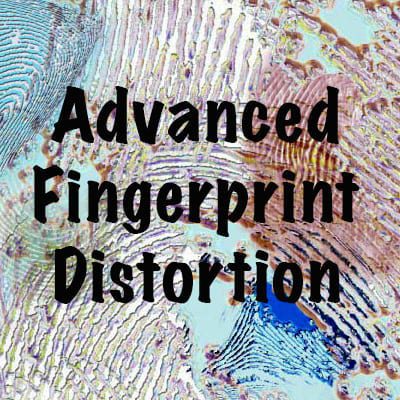
Advanced Fingerprint Distortion
Approved for four (4) hours toward IAI Latent Print and Tenprint Certification and Recertification.
Instructor: Alice White
Duration: 4 hours
This webinar is adapted from elements of the Analysis of Distortion in Latent Prints workshop that Alice has taught since 2006. In this course Alice will introduce the anatomical structures of the finger that influence the behavior of the friction ridge skin when it moves on a surface.
After reviewing basic concepts and terminology in contact mechanics, attendees will learn how the skin behaves under four different types of shearing stress. For each type of shearing stress, the attendee will be able to view videos of the skin deforming as it slides on the surface and the resulting latent print.
In some of the most complicated samples, Alice will demonstrate what happens when shearing stress is accompanied by changes in compressive stress or angle of contact. The possible risks of treating these impressions “as one impression” will be discussed and examples provided.
Important lessons from this webinar include 1) sources of missing or false minutiae and 2) how the effects of shearing stress lead to incorrect interpretation of deposition pressure.
Learning Outcomes:
- The attendee will be able to list the main anatomical structures of the finger.
- The attendee will be able to define elastic deformation.
- The attendee will be able to describe how deposition pressure affects center of ridge to center of ridge measurements.
- The attendee will be able to recognize the elements of shearing stress in latent fingerprints.
- The attendee will be able to recognize the direction of shearing stress in latent fingerprints.
- The attendee will be able to define stick region, incipient slip, and gross slip.
- The attendee will be able to describe how shearing stress affects center of ridge to center of ridge measurements.
- The attendee will be able to explain how compression wrinkles can be induced in friction ridge skin.
- The attendee will be able to recognize misaligned ridges in latent fingerprints.
Course Handout: Prior to the webinar (typically 1 – 2 days) you will receive an email link to a file or folder to download the handout and any relevant supplemental information. The main course handout can also be downloaded from the webinar platform at the time of the webinar.
Assessing Learning Outcomes (a.k.a. Quiz): In order to verify the learning outcomes have been achieved, there is a 20 question quiz via SurveyMonkey at the end of each webinar. Attendees must score a minimum of 70% on the quiz in order to receive a training certificate for the webinar. Please note the quizzes are open-book and poll questions are given during the webinar to prepare attendees for the quiz.
Attendance Policy: This webinar may only be attended by the person who is registered for the webinar. Evolve Forensics does not permit broadcasting, watching, listening, or distributing the webinar or any of the webinar handouts to individuals who are not registered for this webinar.
Software Requirements: Attendees must be able to access GoToWebinar (webinar platform) and SurveyMonkey (quiz platform) in order to participate.
The following YouTube Video shows how to use GoToWebinar as an attendee: https://youtu.be/IQ3Xwwgbd8Y
Questions?
Please contact Alice White via email at [email protected]
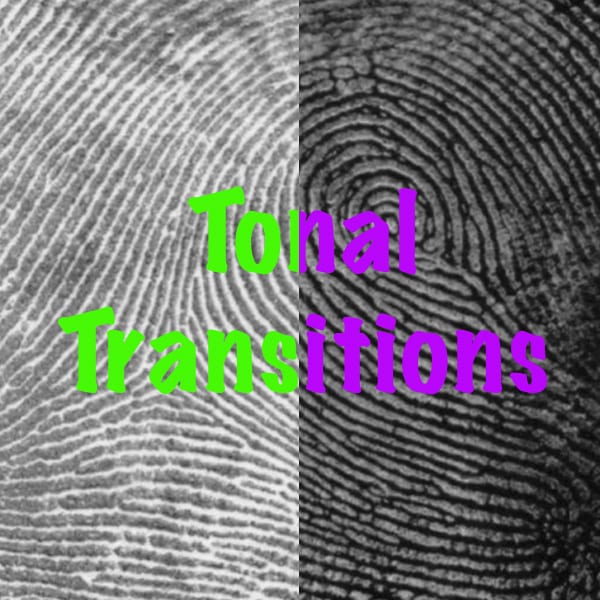
Tonal Transitions: Causes and Visual Effects
Approved for four (4) hours toward IAI Latent Print and Tenprint Certification and Recertification.
Instructor: Alice White
Duration: 4 hours
This webinar is adapted from elements of the Analysis of Distortion in Latent Prints workshop that Alice has taught since 2006. Ideally, the ridges in the friction ridge skin contact a surface and transfer an even coating of residue to the surface. This residue is then targeted by a latent print development technique, resulting in an impression that has distinctive ridges and furrows that require minimal eye strain to follow. But the world of latent prints is rarely so neat and tidy.
In this webinar we will look at many ways the ridges and furrows stray from this ideal condition. We will first discuss the composition of latent print residue (research has demonstrated it is NOT 98-99% water – we will dive into the source of this misconception). We will then discuss the different ways residue can be distributed across the surface of the skin and how this distribution matters when a surface is touched.
After contact with a surface has been made, the manner in which the skin slides through the residue wreaks all kinds of havoc on the tone of the ridges and furrows – we will explore the many visual anomalies associated with movement. Lastly, we will discuss the impact of surfaces that already have contaminants and how this affects the transfer of residue, and consequently the appearance of the ridges and furrows.
Learning Outcomes:
- The attendee will be able to describe the three-dimensional features of the friction ridge skin.
- The attendee will be able to list the main components of latent print residue.
- The attendee will be able to describe the different ways residue can be distributed on the friction ridge skin.
- The attendee will be able to describe how the distribution of the residue on the skin impacts the transfer of the residue to a surface and creates tonal transitions.
- The attendee will be able to recognize variation in ridge and furrow appearance due to movement of the friction ridge skin on a surface.
- The attendee will be able to explain how contaminated surfaces can impact the tonal appearance of ridges and furrows.
Course Handout: Prior to the webinar (typically 1 – 2 days) you will receive an email link to a file or folder to download the handout and any relevant supplemental information. The main course handout can also be downloaded from the webinar platform at the time of the webinar.
Assessing Learning Outcomes (a.k.a. Quiz): In order to verify the learning outcomes have been achieved, there is a 20 question quiz via SurveyMonkey at the end of each webinar. Attendees must score a minimum of 70% on the quiz in order to receive a training certificate for the webinar. Please note the quizzes are open-book and poll questions are given during the webinar to prepare attendees for the quiz.
Attendance Policy: This webinar may only be attended by the person who is registered for the webinar. Evolve Forensics does not permit broadcasting, watching, listening, or distributing the webinar or any of the webinar handouts to individuals who are not registered for this webinar.
Software Requirements: Attendees must be able to access GoToWebinar (webinar platform) and SurveyMonkey (quiz platform) in order to participate.
The following YouTube Video shows how to use GoToWebinar as an attendee: https://youtu.be/IQ3Xwwgbd8Y
Questions?
Please contact Alice White via email at [email protected]
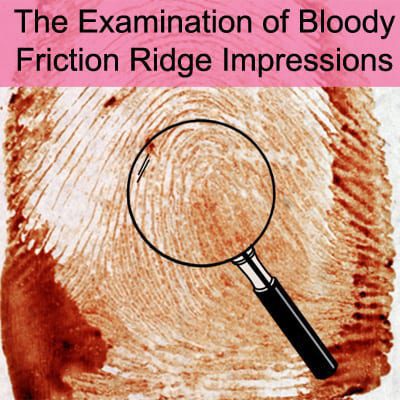
Examination of Bloody Friction Ridge Impressions
Approved for four (4) hours toward IAI Latent Print Certification and Recertification.
Instructor: Dr. Glenn Langenburg
Duration: 4 hours
Blood matrix can be one of the more difficult factors affecting the interpretation of friction ridges. Owing to its unique composition, blood creates many unusual artifacts in friction ridge impressions. We will examine the range of bloody impressions from liquid, to tacky, to nearly dry. Furthermore, we will examine the typical characteristics that manifest in bloody impressions. We will watch the moments blood impressions are deposited and what happens to them as they dry. Finally, we will review the literature and research regarding ‘activity level’ statements such as if a bloody impression was made in blood or made with blood.
Learning Outcomes:
- The attendee will be able to identify the characteristics of blood.
- The attendee will be able to identify critical research studies demonstrating the deposition of bloody fingerprints.
- The attendee will be able to recognize the influence of substrates on blood depositions.
- The attendee will be able to identify the effects of pressure, volume, and drying on blood print depositions.
- The attendee will be able to describe typical artifacts and distortions encountered in bloody impressions.
- The attendee will be able to recognize different activity level scenarios related to the deposition of bloody impressions.
- The attendee will be able to list the limitations of examining bloody impressions.
Course Handout: You will receive an email link several days before class to download the handouts and supporting literature. If you are unable to access the link due to agency restrictions, the handouts will be available during the webinar for downloading as well.
Assessing Learning Outcomes (a.k.a. Quiz): In order to verify the learning outcomes have been achieved, there is a 20 question quiz via SurveyMonkey at the end of each webinar. Attendees must score a minimum of 70% on the quiz in order to receive a training certificate for the webinar. Please note the quizzes are open-book and poll questions are given during the webinar to prepare attendees for the quiz.
Attendance Policy: This webinar may only be attended by the person who is registered for the webinar. Evolve Forensics does not permit broadcasting, watching, listening, or distributing the webinar or any of the webinar handouts to individuals who are not registered for this webinar.
Software Requirements: Attendees must be able to access GoToWebinar (webinar platform) and SurveyMonkey (quiz platform) in order to participate.
The following YouTube Video shows how to use GoToWebinar as an attendee: https://youtu.be/IQ3Xwwgbd8Y
Questions?
For questions regarding the course content, please contact Glenn Langenburg via email at [email protected]
For questions regarding registration and payment processes, please contact Alice White via email at [email protected]
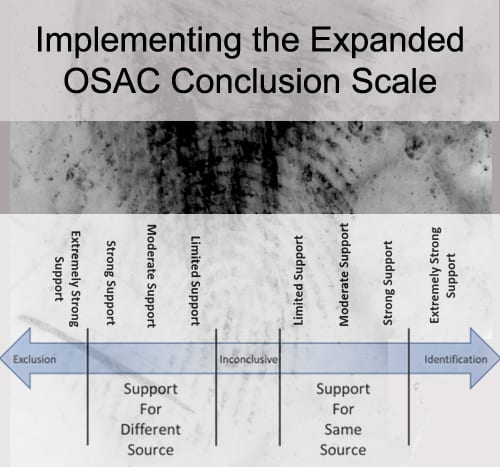
Implementing the Expanded OSAC Conclusion Scale
Approved for four (4) hours toward IAI Latent Print Certification and Recertification.
Instructor: Dr. Glenn Langenburg
Duration: 4 hours
Attendees will review the 2018 OSAC proposed standard “Standard for Friction Ridge Examination Conclusions” and Glenn will outline how to introduce and implement this standard into ISO accredited procedures. We will explore the importance of qualitative versus quantitative results, relative magnitude, and how to understand the significance of these terms. We will define these terms and how they differ from current terms. Glenn will propose methods for testing the use of this scale and what is required to implement the standard into casework in an accredited agency.
Learning Outcomes:
- The attendee will be able to define qualitative and quantitative likelihood ratios (LRs).
- The attendee will be able to define the OSAC categorical conclusions.
- The attendee will be able to list and define the competing source propositions.
- The attendee will be able to explain the importance of relative magnitude of support.
- The attendee will be able to apply the OSAC terms to practical examples of latent prints.
- The attendee will be able to describe methods for testing and implementing the terms into casework.
- The attendee will be able to describe reporting language and requirements.
- The attendee will be able to describe how conflict resolution is impacted by the use of this scale.
Course Handout: You will receive an email link several days before class to download the handouts and images. This will give you an opportunity to come to the webinar with the exercises already prepared and we can discuss as a group. The pre-course work may take about an hour to review. If you are unable to download or work the exercises in time, you can still participate in the webinar, but you will have less time to review the exercises in real time.
Course Pre-Requisites: You should have an understanding of current reporting practices and the current SWGFAST/ENFSI conclusions in the field of fingerprints (i.e., Identification, Exclusion, Inconclusive, and various forms of Inconclusive).
Assessing Learning Outcomes (a.k.a. Quiz): In order to verify the learning outcomes have been achieved, there is a 20 question quiz via SurveyMonkey at the end of each webinar. Attendees must score a minimum of 70% on the quiz in order to receive a training certificate for the webinar. Please note the quizzes are open-book and poll questions are given during the webinar to prepare attendees for the quiz.
Attendance Policy: This webinar may only be attended by the person who is registered for the webinar. Evolve Forensics does not permit broadcasting, watching, listening, or distributing the webinar or any of the webinar handouts to individuals who are not registered for this webinar.
Software Requirements: Attendees must be able to access GoToWebinar (webinar platform) and SurveyMonkey (quiz platform) in order to participate.
The following YouTube Video shows how to use GoToWebinar as an attendee: https://youtu.be/IQ3Xwwgbd8Y
Questions?
For questions regarding the course content, please contact Glenn Langenburg via email at [email protected]
For questions regarding registration and payment processes, please contact Alice White via email at [email protected]
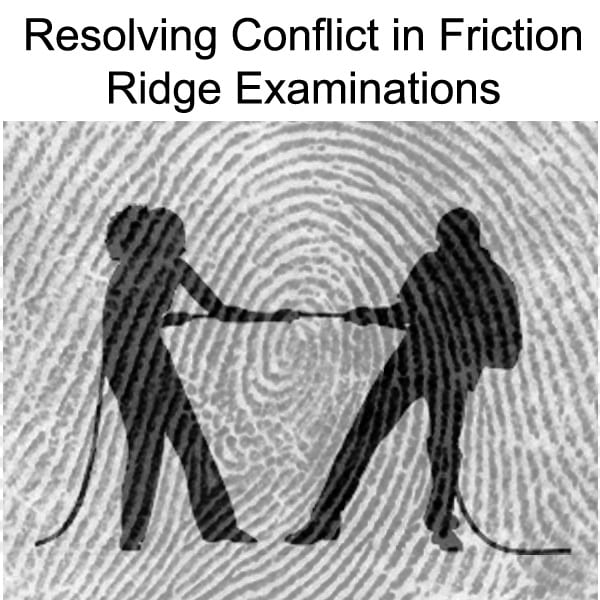
Resolving Conflict in Friction Ridge Examinations
Approved for three (3) hours toward IAI Latent Print Certification and Recertification.
Instructor: Dr. Glenn Langenburg
Duration: 3 hours
Conflicting opinions in friction ridge examinations are inevitable events. Some agencies do not have a policy for resolving conflict; some that do have them are not very specific. How are examiners supposed to “see if they can resolve the conflict” if there are not specific recommendations and clear instructions for doing so? This webinar explores concrete methods for resolving conflict and deciding what to report. We will use case examples to illustrate specific scenarios and how to resolve them.
Learning Outcomes:
- The attendee will be able to define conflict resolution.
- The attendee will be able to identify critical research studies that demonstrate conflicting conclusions.
- The attendee will be able to apply the Montani Method for identifying the source of conflict.
- The attendee will understand how differences in likelihood ratios lead to conflicting opinions.
- The attendee will be able to describe different reporting mechanisms for conflicting opinions.
- The attendee will be able to identify and locate sources for developing conflict resolution protocols.
Course Handout: You will receive an email link several days before class to download the handouts and supporting literature. If you are unable to access the link due to agency restrictions, the handouts will be available during the webinar for downloading as well.
NOTE: This course will use the 2018 Proposed OSAC Conclusion Scale as a means of conversing about examiners’ opinions. Attendees need not have attended “Implementing the OSAC Conclusion Scale” webinar, but it will be helpful in this course.
Assessing Learning Outcomes (a.k.a. Quiz): In order to verify the learning outcomes have been achieved, there is a 20 question quiz via SurveyMonkey at the end of each webinar. Attendees must score a minimum of 70% on the quiz in order to receive a training certificate for the webinar. Please note the quizzes are open-book and poll questions are given during the webinar to prepare attendees for the quiz.
Attendance Policy: This webinar may only be attended by the person who is registered for the webinar. Evolve Forensics does not permit broadcasting, watching, listening, or distributing the webinar or any of the webinar handouts to individuals who are not registered for this webinar.
Software Requirements: Attendees must be able to access GoToWebinar (webinar platform) and SurveyMonkey (quiz platform) in order to participate.
The following YouTube Video shows how to use GoToWebinar as an attendee: https://youtu.be/IQ3Xwwgbd8Y
Questions?
For questions regarding the course content, please contact Glenn Langenburg via email at [email protected]
For questions regarding registration and payment processes, please contact Alice White via email at [email protected]
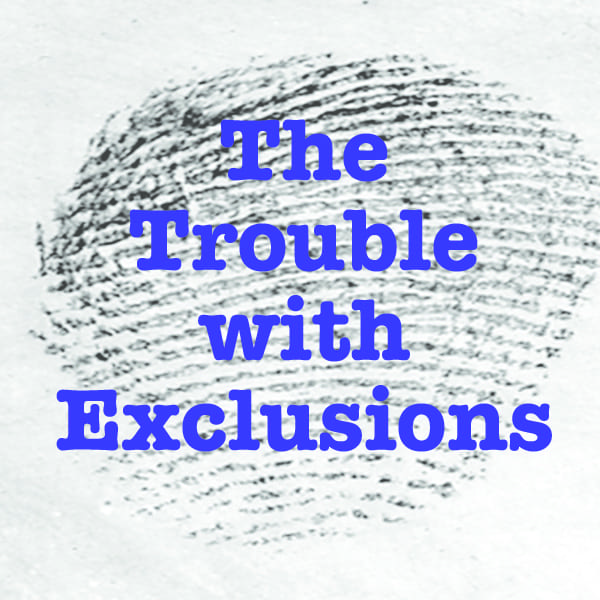
The Trouble With Exclusions
Approved for four (4) hours toward IAI Latent Print and Tenprint Certification and Recertification.
Instructor: Alice White
Duration: 4 hours
This course will use three regions of the friction ridge skin to demonstrate the difficulty with exclusions: extreme tips of fingers, extreme edges of fingers, and impressions from proximal and medial phalanges. These regions will illustrate the importance of understanding the completeness of exemplar prints and appropriate conclusions.
With tips and edges of fingers we will focus on the challenge of approximating the distance and angle to the core or a delta. With the lower segments of the finger we will focus on the challenges of determining 1) medial from proximal segment, 2) lateral position along the segment, and 3) variation in the recording of the secondary creases.
In addition to these problematic areas of the friction ridge skin, Alice will demonstrate same source samples that would likely result in a high false exclusion rate simply due to the differences caused by distortion. Attendees should leave this webinar with a better grasp of why the false exclusion rate will likely always be higher than the false identification rate.
Learning Outcomes:
- The attendee will be able to describe the two phases of the comparison process.
- The attendee will be able to define the following conclusions: Inconclusive, Support for Different Source, and Exclusion.
- The attendee will be able to list the three possible outcomes that are driven by the quality of the exemplar prints.
- The attendee will be able to list the issues that should be considered before rendering an exclusion decision.
- The attendee will be able to describe the cautions that should be taken with impressions from the extreme tips of the fingers.
- The attendee will be able to describe the cautions that should be taken with impressions from the edges of the fingers.
- The attendee will be able to describe the cautions that should be taken with impressions from the lower portions of the fingers.
- The attendee will be able to describe how same source impressions can lead to erroneous exclusions.
Course Handout: Prior to the webinar (typically 1 – 2 days) you will receive an email link to a file or folder to download the handout and any relevant supplemental information. The main course handout can also be downloaded from the webinar platform at the time of the webinar.
Assessing Learning Outcomes (a.k.a. Quiz): In order to verify these learning outcomes have been achieved, there is a 20 question quiz via SurveyMonkey at the end of each webinar. Attendees must score a minimum of 70% on the quiz in order to receive a training certificate for the webinar. Please note the quizzes are open-book and poll questions are given during the webinar to prepare attendees for the quiz.
Attendance Policy: This webinar may only be attended by the person who is registered for the webinar. Evolve Forensics does not permit broadcasting, watching, listening, or distributing the webinar or any of the webinar handouts to individuals who are not registered for this webinar.
Software Requirements: Attendees must be able to access GoToWebinar (webinar platform) and SurveyMonkey (quiz platform) in order to participate.
The following YouTube Video shows how to use GoToWebinar as an attendee: https://youtu.be/IQ3Xwwgbd8Y
Questions?
Please contact Alice White via email at [email protected]
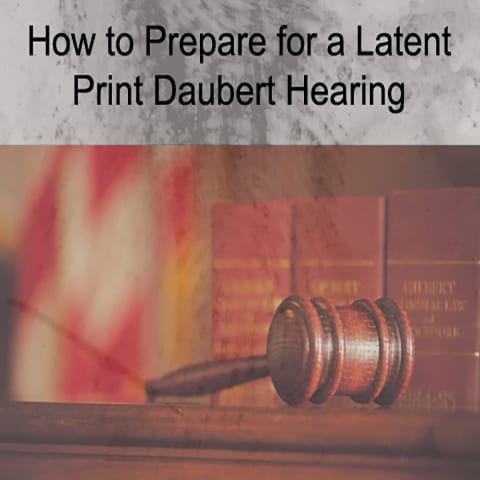
How to Prepare for a Latent Print Daubert Hearing
Approved for four (4) hours toward IAI Latent Print and Tenprint Certification and Recertification (can be applied toward testimony training hours).
Instructor: Dr. Glenn Langenburg
Duration: 4 hours
In this course, attendees will learn helpful strategies for preparing for admissibility hearings. We will discuss the difference between Frye and Daubert hearings (or 702 hearings or equivalent). Glenn will demonstrate different strategies for addressing ‘general acceptance’ of fingerprint methodology. We will review various peer-reviewed research papers that demonstrate ‘testing and validation’ of fingerprint methodology. We will review industry standards that are available to the analyst. We will discuss critical error rate studies and we will review a strategy for addressing the known or potential error rate of latent print methodology. Finally, we will examine some limitations of fingerprint methodology which need to be acknowledged.
Learning Outcomes:
- The attendee will be able to define Frye versus Daubert admissibility standards.
- The attendee will be able to define and apply the term ‘general acceptance’.
- The attendee will be able to list critical literature to demonstrate testing and validation of ACE-V.
- The attendee will be able to identify industry standards.
- The attendee will be able to define and apply the term ‘peer review’.
- The attendee will be able to identify critical error rate studies.
- The attendee will be able to provide error rate statistics from peer-reviewed publications.
- The attendee will be able to answer simple courtroom style questions regarding how the Daubert factors can be applied with respect to fingerprint methodology.
- The attendee will be able to list limitations of the ACE-V methodology.
Course Handout: You will receive an email link several days before class to download the handouts and supporting literature. The pre-course work may take about an hour to review. If you are unable to download or review the material in time, you may still participate in the webinar.
Course Pre-Requisites: You should have an understanding of how basic latent print testimony is given in criminal and civil matters. There will be a significant number of research papers discussed in this course. Reading in advance can help if you are not familiar with error rates, statistics, and complex research topics.
Assessing Learning Outcomes (a.k.a. Quiz): In order to verify the learning outcomes have been achieved, there is a 20 question quiz via SurveyMonkey at the end of each webinar. Attendees must score a minimum of 70% on the quiz in order to receive a training certificate for the webinar. Please note the quizzes are open-book and poll questions are given during the webinar to prepare attendees for the quiz.
Attendance Policy: This webinar may only be attended by the person who is registered for the webinar. Evolve Forensics does not permit broadcasting, watching, listening, or distributing the webinar or any of the webinar handouts to individuals who are not registered for this webinar.
Software Requirements: Attendees must be able to access GoToWebinar (webinar platform) and SurveyMonkey (quiz platform) in order to participate.
The following YouTube Video shows how to use GoToWebinar as an attendee: https://youtu.be/IQ3Xwwgbd8Y
Questions?
For questions regarding the course content, please contact Glenn Langenburg via email at [email protected]
For questions regarding registration and payment processes, please contact Alice White via email at [email protected]
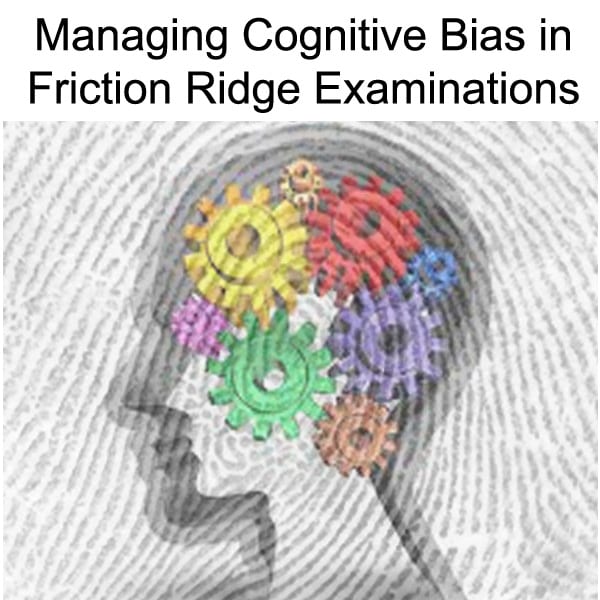
Managing Cognitive Bias in Friction Ridge Examinations
Approved for three (3) hours toward IAI Latent Print and Tenprint Certification and Recertification.
Instructor: Dr. Glenn Langenburg
Duration: 3 hours
Now, more than ever, forensic service providers are required to demonstrate their commitment to impartiality (ISO/IEC 17025:2017 4.1). This training addresses this issue by exploring how cognitive bias can influence friction ridge examinations. In this 3-hour course, we will identify potential sources of cognitive bias in friction ridge examinations and examine how it may impact our decision-making. We will review the current literature on this topic and critical findings. To see how bias can impact our casework we will review fingerprint cases (some famous, some not) where bias contributed to the error or the management of the error. Lastly, we will identify specific actions, best practices, and procedures that you can adopt to minimize the impact of potential bias. Attendees of this course will be provided with specific examples of how to conduct blind examinations, case-manager models, and sequential unmasking approaches.
Learning Outcomes:
- The attendee will be able to define sources of cognitive bias.
- The attendee will be able to identify critical research studies exploring the effects of cognitive bias.
- The attendee will be able to describe critical elements that led to the error in the Mayfield case.
- The attendee will be able to identify blind spots in the ACE-V process.
- The attendee will be able to describe de-biasing techniques that can be deployed before and during casework.
Course Handout: You will receive an email link several days before class to download the handouts and supporting literature. If you are unable to access the link due to agency restrictions, the handouts will be available during the webinar for downloading as well.
Assessing Learning Outcomes (a.k.a. Quiz): In order to verify the learning outcomes have been achieved, there is a 20 question quiz via SurveyMonkey at the end of each webinar. Attendees must score a minimum of 70% on the quiz in order to receive a training certificate for the webinar. Please note the quizzes are open-book and poll questions are given during the webinar to prepare attendees for the quiz.
Attendance Policy: This webinar may only be attended by the person who is registered for the webinar. Evolve Forensics does not permit broadcasting, watching, listening, or distributing the webinar or any of the webinar handouts to individuals who are not registered for this webinar.
Software Requirements: Attendees must be able to access GoToWebinar (webinar platform) and SurveyMonkey (quiz platform) in order to participate.
The following YouTube Video shows how to use GoToWebinar as an attendee: https://youtu.be/IQ3Xwwgbd8Y
Questions?
For questions regarding the course content, please contact Glenn Langenburg via email at [email protected]
For questions regarding registration and payment processes, please contact Alice White via email at [email protected]

